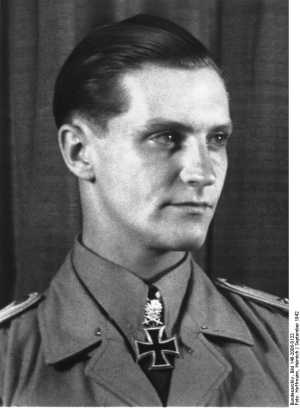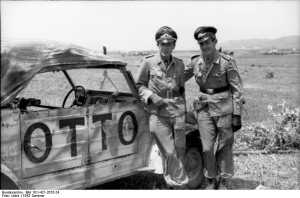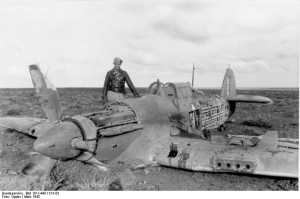Hans-Joachim "Jochen" Marseille
"The Star of Africa"
By Stephen Sherman, Dec. 2008. Updated July 7, 2011.
One of the real playboys among the Experten was Hans-Joachim Marseille. Fighter pilots have always had an eye for the ladies, but Marseille, with his striking good looks and fame as the "Star of Africa," really indulged in extra-curricular activities. At 158 aerial victories, he was the leading Luftwaffe ace against Western fliers, and one of the nine aces to earn the "Diamonds."
Born in 1919, the son of an Army officer, Marseille joined the Luftwaffe in 1938. He qualified as a fighter pilot and was selected as an officer candidate, but, due to his lack of discipline and irresponsibility, was the last of his cadet class to earn his commission. Assigned to I/JG 2 in August 1940, he shot down his first enemy airplane, a Hawker Hurricane that month. His undisciplined attitude extended to his flying, as he would plunge into any dogfight, regardless of the tactical situation. During the Battle of Britain, he claimed five more victories, and was himself, shot down four times over the Channel.
He partied so hard that he frequently was unfit to fly, so that his commander, Macky Steinhoff, wanted him out, and he was transferred to I/JG 27 by the end of the year. The commander of that unit was considerably more flexible, and when they were transferred to Libya in April, 1941, the dearth of women helped Marseille focus on his work.
Marseille increased his skills gradually, learning to get close, close, close to his targets. By getting close and developing his deflection shooting, he minimized the amount of ammunition used to shoot down each victim, averaging just fifteen bullets each! His victories and medals mounted up: by February 1942, he had 50 and the Ritterkreuz; by June 6, 75 and the Eichenlaub. In the summer of 1942, he really hit his stride, and in just twelve days in June, shot down another twenty-six, for a total of 101, earning the Schwerter. On one day, September 2, he shot down seventeen aircraft in three sorties, bringing his total to 126, and earning him the Billanten.
September would see him score 54 kills, his most productive month. The 17 enemy aircraft shot down included eight in 10 minutes, as a result of this feat he was presented with a type 82 Volkswagen Kübelwagen by an Italian Regia Aeronautica squadron. This was the most aircraft from Western Allied air forces shot down by a single pilot in one day. Meeting Rommel, on 16 September, "The Desert Fox" congratulated Marseille on becoming the youngest Hauptmann in the Luftwaffe.
Marseille continued scoring multiple kills throughout September, including seven on 15 September. Between 16-25 September Marseille failed to increase his score due to a fractured arm. As a result he had been forbidden from flying by Eduard Neumann. Marseille had borrowed a Macchi C.205 from neighbouring Italian Squadron to test fly. The aircraft was the personal "mount" of Italian ace Lt Emanuele Annoni. Marseille crashed the aircraft on landing, highlighting his deficiencies in Marseille's flying skills. Marseille was becoming physically exhausted by the frenetic pace of combat. After his last combat on the 26 September, Marseille was reportedly on the verge of collapse after a 15-minute battle with a formation of Spitfires, during which he scored his seventh victory of that day.
Death
The two missions of 26 September 1942 had been flown in Bf 109G-2/Trops, in one of which Marseille had shot down seven enemy aircraft. Over the next three days Marseille's Staffel was rested and taken off flying duties. On 28 September Marseille received a telephone call from Generalfeldmarschall Erwin Rommel asking to return with him to Berlin, but Marseille declined for personal reasons. In a 1955 biographical movie, it was intimated that he had become aware of the Holocaust and disdained meeting Hitler on that account, but, there's no real evidence of this.
On 30 September 1942, Marseille was leading his Staffel on a Stuka escort mission, during which no contact with enemy fighters was made. While returning to base, his new Bf 109G-2/Trop's cockpit began to fill with smoke; blinded and half asphyxiated, he was guided back to German lines by his wingmen. Upon reaching friendly lines, "Yellow 14" had lost power and was drifting lower and lower. Marseille deemed his aircraft no longer flyable and decided to bail out, his last words being "I've got to get out now, I can't stand it any longer".
His Staffel, which had been flying a tight formation around him, peeled away to give him the necessary room to maneuver. Marseille rolled his aircraft onto its back, the standard procedure for bail out, but due to the smoke and slight disorientation, he failed to notice that the aircraft had entered a steep dive and was now travelling at a considerably faster speed. He worked his way out of the cockpit and into the rushing air only to be carried backwards by the slipstream, the left side of his chest striking the vertical stabiliser of his fighter, either killing him instantly or rendering him unconscious to the point that he could not deploy his parachute. He fell almost vertically, hitting the desert floor seven km south of Sidi Abdel Rahman. He had not even attempted to open his parachute, and was dead by the time he hit the ground.
His death, along with two other aces, severely affected morale in JG 27, and the unit was shortly withdrawn from North Africa. Many authorities regard Marseille as the best marksman and the best fighter pilot of WW2. The rudder of his last airplane, marked with his 158 victories, is in the Luftwaffe museum in Berlin.
Sources
Aces of the Reich: The Making of a Luftwaffe Fighter Pilot, by Mike Spick, Greenhill Books, London, 2006
Illustrated Dictionary of Fighting Aircraft of World War II, by Bill Gunston, Salamander Books, London, 1988
Wikipedia's encyclopedic entry.




